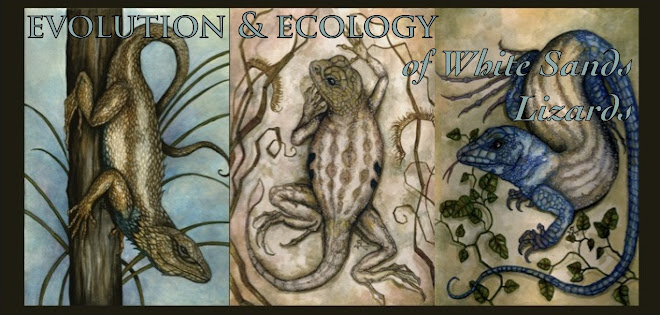Good Evening!
Well it has been a very busy few days... but I think it is about time I sketch out an overview of my current project for those of you who are yet unfamiliar.
Previously, my research focused on the ecology side of adaptation - especially habitat use and functional morphology (linking lizard's
traits with how they perform - eat, bite, escape predators, and sprint).
 |
| The little striped whiptail (A. inornata) with a tasty, grubby snack under the shade on the ecotone of White Sands and the surrounding Chihuahuan Desert. |
For her doctorate degree, one of my advisors,
Erica B. Rosenblum, researched parallel adaptation of three species of lizards to White Sands. She found that not only do the three species show directional change in colour (they are more 'blanched' on White Sands), but they also generally have longer legs and broader heads for their body size. My results from two years ago also demonstrated that White Sands earless and whiptail lizards were larger than their darker counterparts living in the dark soiled Chihuahuan desert.
 |
| Jackie and Mikki checking out a muddy puddle outside the ecotone of White Sands. |
For my current project, I am examining whether there is current natural selection on lizards living on the ecotone of White Sands. But HOW? We are using
mark-recapture to determine whether lizards with certain traits (colour brightness, head size, limb length...) are more likely to survive from one capture event to another. We mark the lizards using elastomer tags (a fluorescent plastic polymer that I inject with an insulin needle just under the lizard's skin) and generate unique tags using five colours in four locations on the lizards' little bellies. This way, we can measure each lizard's features and keep track of each individual over subsequent capture events. If we do not recapture a lizard, it is likely it has died within the time since the last capture... there is of course, some chance a lizard has just wandered further away. By recapturing multiple times, we can increase our chances that we will find such distant travelers... and be more certain that we are accurately measuring differential survival in our sample populations.
Last year, we began the mark-recapture experiment on the lesser earless lizard,
Holbrookia maculata. We first sampled in May-June, and then recaptured in August. We had about a 60-70% recapture rate... meaning, we 60-70% of the lizards we captured in August were already tagged and had survived since the spring.
 |
| A male lesser earless lizard (H. maculata) after just being released. The black dot on his tail is another mark to show us that he has already been caught this time around. The mark is just done with Sharpie and will wash or shed off in a few days. The elastomer marks, however, are inert and mostly permanent, and can hardly be seen in daylight even when the lizard is viewed from below. |
Our results from last year already showed some interesting patterns... lizards increased in condition (weight per body length) over the summer (as they fattened up in preparation for the autumn), lizards with higher condition in May-June were more likely to be recaptured in August, and finally, lizards that were brighter in May-June were also more likely to be recaptured. Further work this year will help us confirm whether brighter (whiter) lizards in better condition are more likely to survive on the ecotone.
 |
| Mikki readying her noose at our site, "AR02" (Admin Road 02) |
This year, we are continuing our work with the earless lizard, and we have added the eastern fence lizard,
Sceloporus undulatus to our study. So far we've captured 13 fence lizards and 38 earless lizards, 24 of which were survivors from last year! It's shaping up to be a great field season... more next time on our locations and more stories from the field!
Goodnight 8
H. maculata and 7
S. undulatus sharing our apartment tonight...
-S. Des Roches





No comments:
Post a Comment